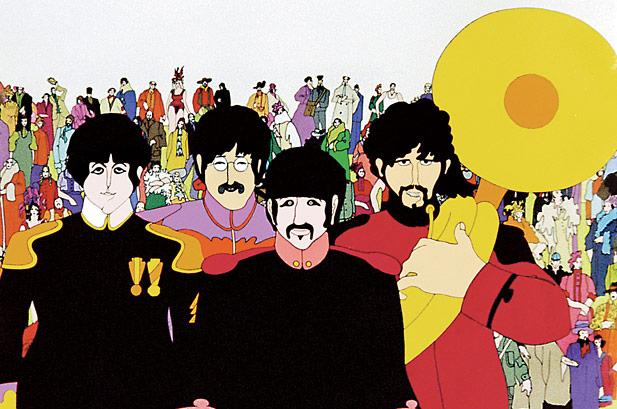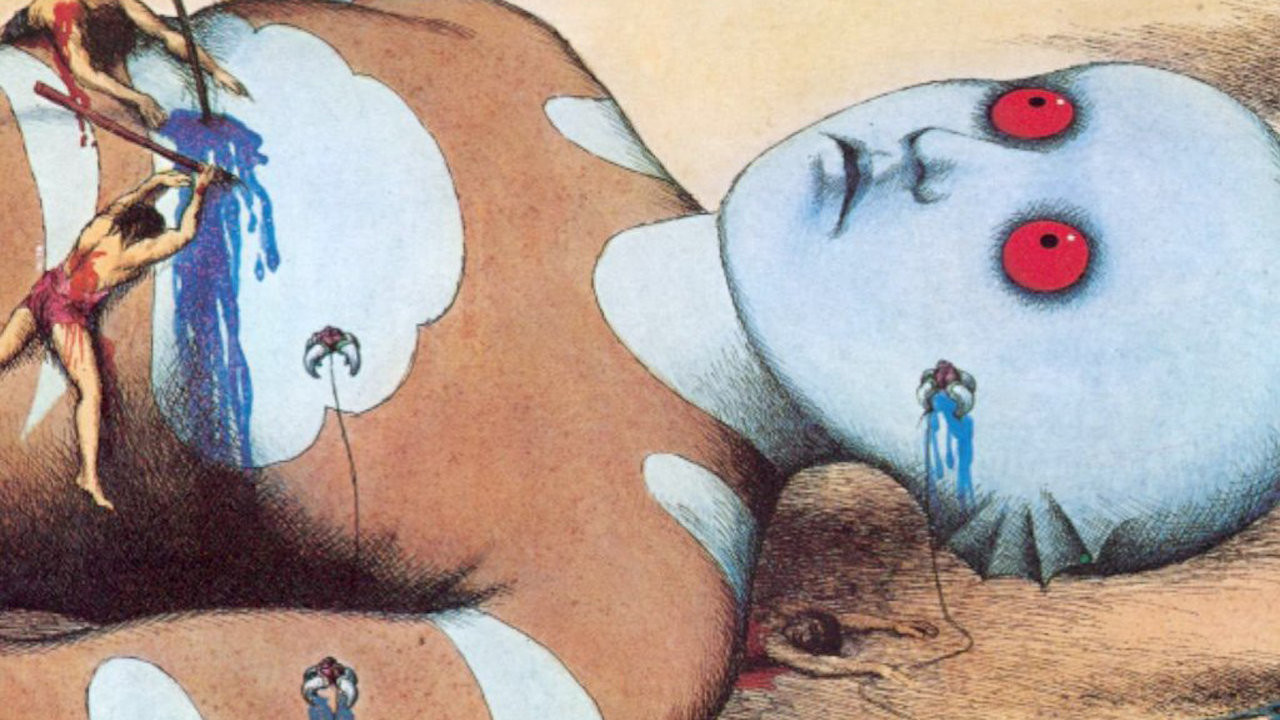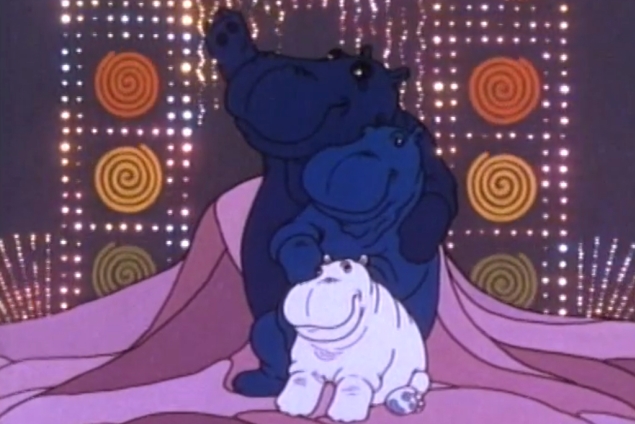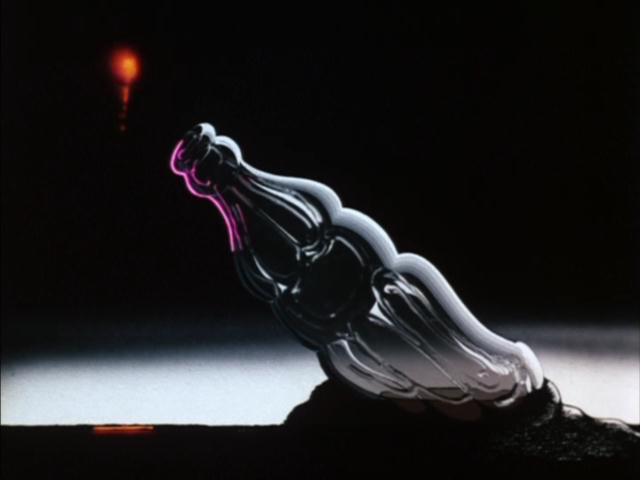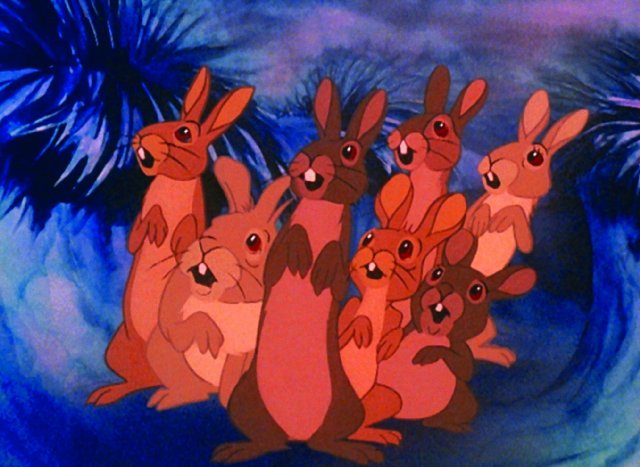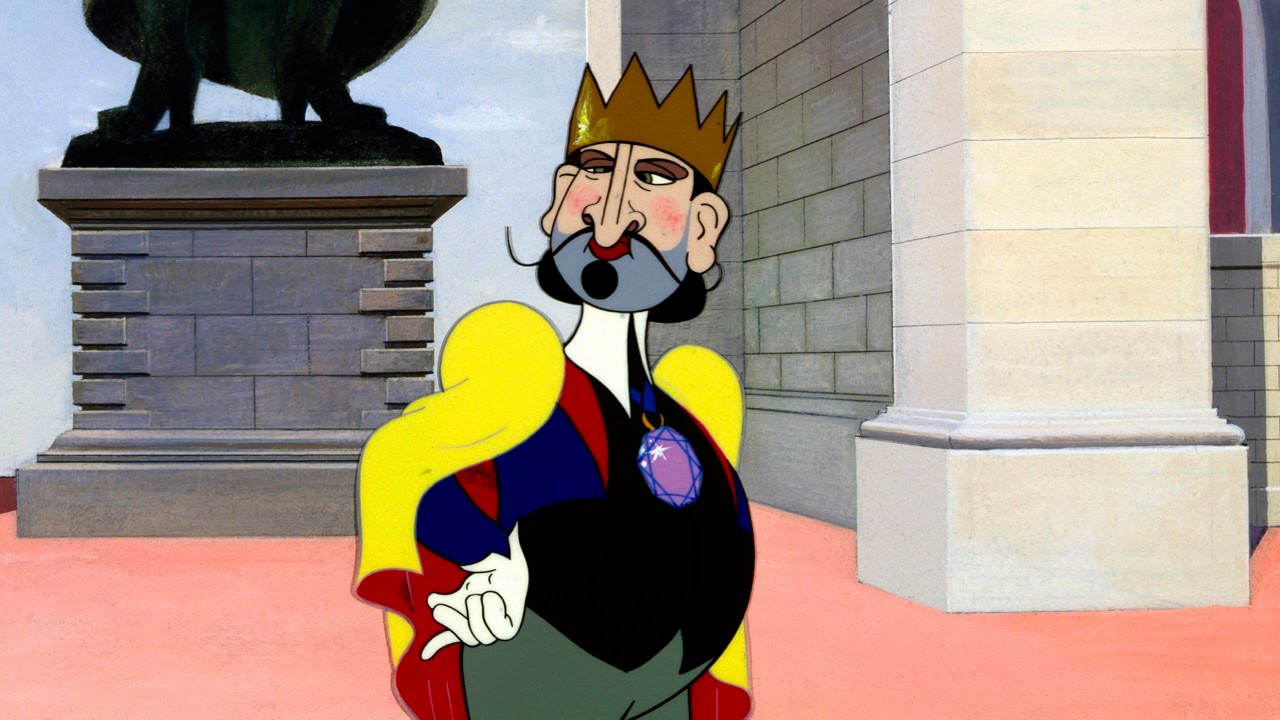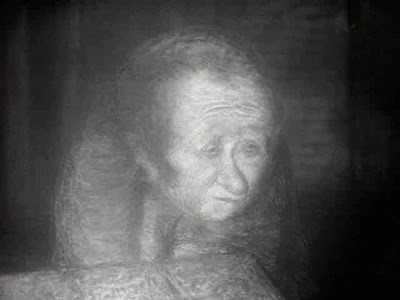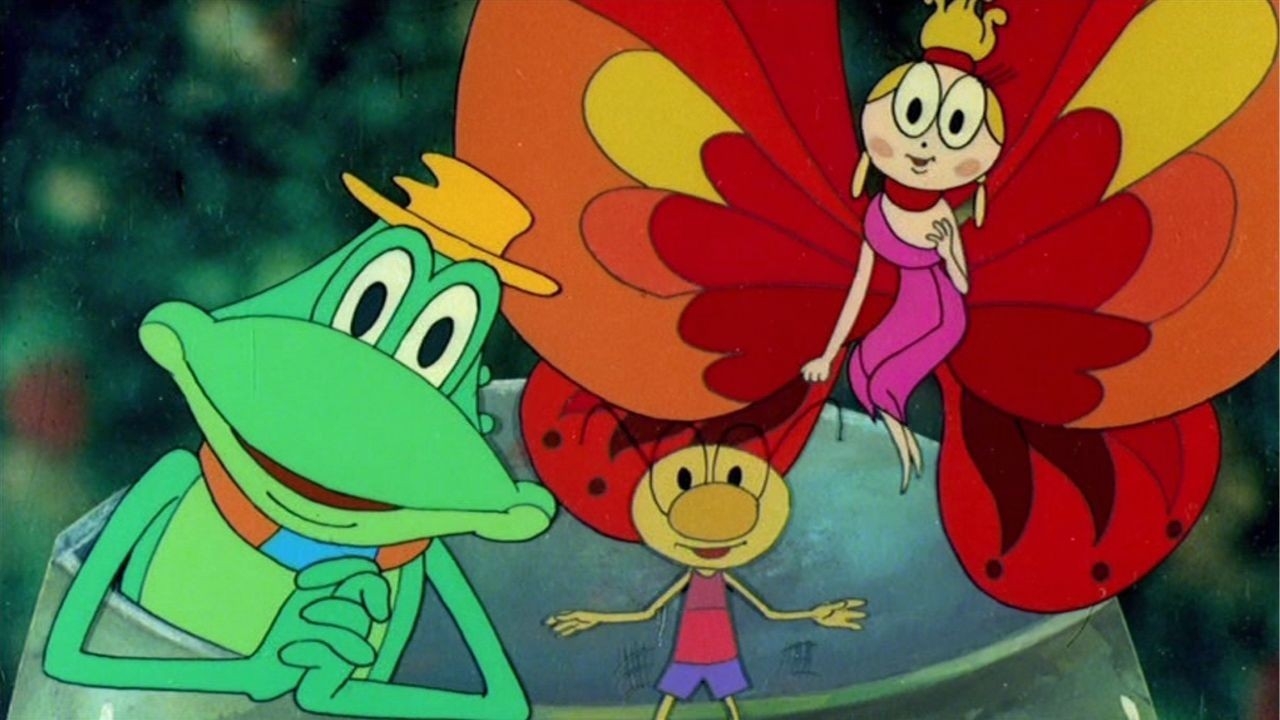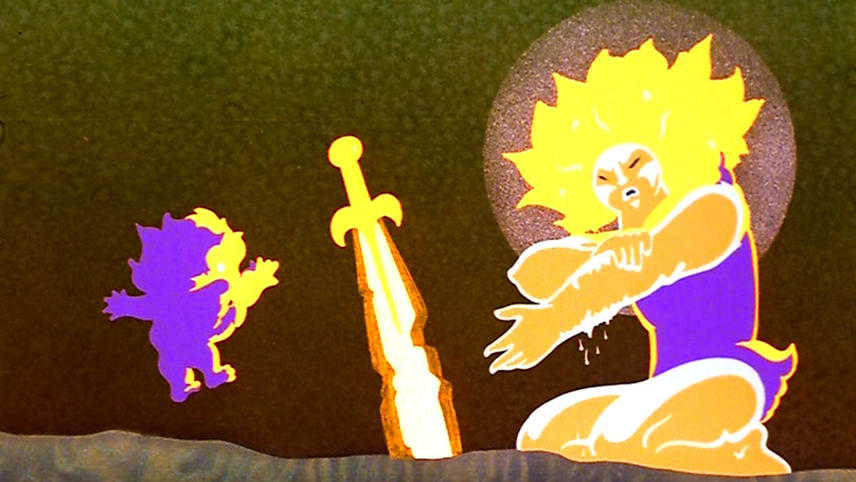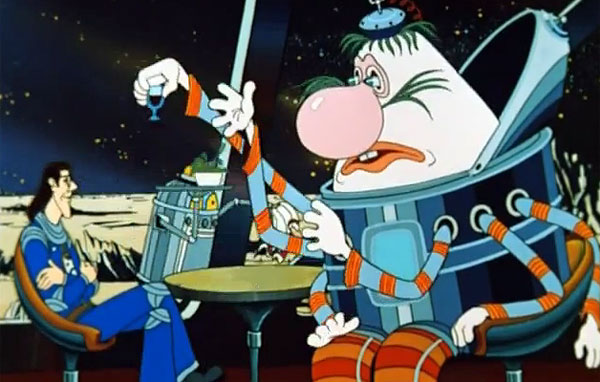11. Yellow Submarine (1968, UK) Dir. by George Dunning
Epic on a number of levels. It’s the best Beatles film (no offense, A Hard Day’s Night!). It showed to the Western world that animation can have a distinct artistic look and feel without catering to kids only. And, it’s more than a film-it’s an experience.
With the backing of Apple Films, the Fab Four’s production company, Dunning had the artistic freedom to perfectly capture the spirit of the 60’s. The plot is loose-The Beatles travel across the Seven Seas in the titular submarine to rescue the Pepperland from the occupation of joyless Blue Meanies, which they eventually do with their song of love, peace, and friendship.
The film’s creative director, Heinz Edelman, brought his Neo-Liberty and psychedelic floral decorativism to give it the signature look, with the help of a team of talented animators (Paul Driessen and Gerald Potterton, among others). The self-irony is one of its many saving graces, as it never takes itself too seriously. An experience that’s still potent and enjoyable.
Other works: this may sound like blasphemy, but Dunning’s shorts are more perfectly realized than this legendary feature. Flying Man (1962), Moonrock (1970), The Maggot (1973), and, especially, the three-minute gem Damon the Mower (1972). He died while working on the feature adaptation of Shakespeare’s The Tempest, and the few sequence he did manage to make show what a loss it was.
12. Fantastic Planet (1973, France/Czechoslovakia) Dir. by Rene Laloux
Cannot be omitted from any list, as it is a true cult classic. The story of human-like Oms living in subjugation by giant, advanced Draags is a 72 min. trip into the fantastic, striking, menacing world. Together with the post-Surrealist artist Roland Topor, Laloux weaves together a narrative that, while shocking and brutal at times, never stops to draw in and amaze.
The background is richly detailed, the cut-out stop-motion is so smooth it feels like a drawn film at times. The story is drowning at times in the visuals, but is, nevertheless, an effective message on the need to be humane and to get along, as well as on the balance between the scientific and spiritual realms, which is relevant today like at no other time.
Other works: more on Laloux later. With him, Topor created two striking shorts, Idle Time (1964) and The Snails (1965). They are both powerful, and the short running time makes the concise and coherent.
13. Hugo the Hippo (1975, Hungary/USA) Dir. by William Feigenbaum and Jozsef Gemes
Even Yellow Submarine cannot prepare one for this trip. Makes to wonder-what kind of grass the American side shared with their Hungarian partners to produce this colorful, often disturbing musical. Do not show to younger children-it will linger. The story features a tiny kingdom of Zanzibar beset by man-eating sharks (dressed in biker gear). To combat them, twelve hippos are imported.
Upon completing the job, they are at first treated well, but then neglected, resulting in them raiding the local farmlands and being brutally exterminated. Only the titular little hippo survives, with the help of the little boy and other children. He is captured and tried, but ultimately exonerated.
However, needs to be seen to be believed. From the biker-sharks, to the brutal killing scene (where hunters and hippos are drawn like clouds and shots are represented by lighting), to the psychedelic garden coming alive (featuring a sword-wielding apple and other aggressive fruits and vegetables) -be warned, this one will stay with you.
The American release version uses the vocal talents of Burl Ives and songs performed by Jimmy and Marie Osmonds, and that alone takes it to another level of zany absurdity.
14. Allegro Non Troppo (1976, Italy) Dir. by Bruno Bozzetto
Who, indeed, is Walt Pisney? This Fantasia-like potpourri film takes the mix of classical music and animation to another hilarious level. BW live action sequences (which unfortunately wear thin after a while) are interspersed with colorful and wacky animations to the tunes of some of the best composers. Debussy’s Prélude à l’après-midi d’un faune plays to the story of an elderly satyr attempting to hook up with lithe and perky nymphs.
Dvorak’s Slavonic Dance No.7 is a satire on conformity among the tribe of cave dwellers. Ravel’s Bolero magnificently shows the evolution (or devolution?) of life on Earth. Sibelius’s Valse triste is set to the truly heart-tugging story of a kitten wandering the ruins of a large house and remembering how it was when it teemed with life (guaranteed to evoke tears).
Vivaldi’s Concerto No. 2 shows a dilemma of an adorable little bee that tries to have a breakfast, but is interrupted each time by an amorous couple frolicking in the meadow. Finally, Stravinsky’s The Firebird is set to the story of creation and original sin-with a twist (the serpent just gives up when he gets the knowledge).
Finally, the whole endeavor literally disintegrates. Each sequence is drawn in its own style (lush and detailed for Bolero, simplistic for Slavonic Dances), and each is worth seeing. Grazie, Bozzetto.
Other works: West and Soda (1965), a parody of Western, is a feature worth seeing. The shorts are of various quality, but the ones not to miss are the hilariously existential Life in a Tin (1967) and the Oscar-nominated Grasshoppers (1990).
15. Watership Down (1978, UK) Dir. by Martin Rosen
Not for small children or faint of heart, but if you seek animation at its best-seek no further. This adaptation of Richard Adams’s book continues to impress and spook.
The story of a group of rabbits seeking a new warren to safely live and thrive in, and on the way enduring violence from man and beast alike is told without any sentiments or attempts to “humanize” the rabbits. These are wild animals in their natural habitat. What makes them relatable is their desire for better life and their camaraderie. The story is shown in a striking visual style, ranging from realistic to dreamy.
The original director John Hubley, a unique visual stylist, passed away and was only able to compete some scenes, but their inclusion in the final cut enriches the look of the film. This true cult classic was recently released by the Criterion Collection, and deservingly so.
16. The King and the Mockingbird (1952/1980, France) Dir. by Paul Grimault
This light and easy-natured masterpiece had a long and torrid production history. Released in an incomplete form in 1952 by the producer and against director’s wishes, it took 15 years for Grimault to buy back the rights and another 13 to finish it as he meant to. The wait was worth it-it’s a joyous fun to see.
The plot centers on the kingdom ruled by the narcissistic and delusional king, who is mercilessly mocked by the top hat-donning Mockingbird. When the portraits of the Chimneysweep and Shepherdess (from Hans Christian Andersen’s tale) come to life, they are pursued by the jealous king, but the Mockingbird is on their side.
The character design, the strange world of the castle and town-all combine to give one a vacation to a fun animated land. The writing of Marcel Carne’s frequent scribe, Jacques Prevert, and the voice work by some of the best French actors only add to its excellence.
17. The Overcoat (1981-, USSR-Russia) Dir. by Yuri Norshteyn
It’s one of the most influential animated films of all time, frequently cited in books and seminars. The artistry transcends the confines of animation. There is just one problem-it’s not finished.
After finishing his legendary Tale of Tales (1979), Yuri Norshteyn began this adaptation of Nikolai Gogol’s eternal humanistic horror story of a petty clerk who scrounges up for an overcoat, but has it stolen and descends into madness and otherworldliness.
Using his method of layers of painted glass, lighting effects, and the combination of drawn and cut-out characters, Norshteyn creates a chilling beautiful wintry St. Petersburg and the child-like main protagonist, whose little joys give him solace in this cold, cruel world. 24 minutes (roughly one-third) are said to be completed, and that footage is what is so frequently cited.
The work has initially stalled due to family tragedies, then-breakup of Soviet Union and transition to market economy. Director is reported to keep on chugging and working on it, it his usual meticulous and detailed manner. As the famous Dostoyevsky saying goes, “We all came out of Gogol’s ‘Overcoat’!”. Let’ hope that Norshteyn eventually comes out of it and gives the world a new standard by which to rate animated films.
Other works: if the 70-min. Overcoat is completed, it will more than double Norshteyn’s current body of work, running time-wise. Of special note are the extraordinary Hedgehog in the Fog (1975) and Tale of Tales (1979). Heron and Crane (1974) is not far behind. Battle of Kerzhenets (1971) and Fox and Hare (1973) also posses original talent.
18. Maria, Mirabela (1981, Romania/USSR) Dir. by Ion Popescu-Gopo
This is charming and inventive live action/animation feature. A Soviet/Romanian co-production, it tells the story of two titular sisters (one more tomboyish than the other) on a mission to find the Forest Fairy and get her to help their animated friends-a frog whose feet froze into ice, a butterfly that can’t fly, and a firefly that catches on fire instead of glowing. High on music and enchanted imagery, and relatively low on outright moralism.
The animated rain sequence in the real forest has to be seen, as well as the feeding frenzy of caterpillars and other magical scenes.
Other works: Shorts A Brief History (1956), Seven Arts (1958), Ecce Homo (1977) and others featuring his “Little Man” are eternally funny.
19. Feherlofia (The Son of the White Mare) (1981, Hungary) Dir. by Marcell Jankovics
Take a talented graphic artist, give him an ancient legend and free rein-and be prepared to be hypnotized and astonished. This is almost a completely experimental and purely visual work. The legend of the titular hero’s quest is presented in a strikingly colorful style, mixing styles from fauvism, to Art Nouveau, to Art Deco. Ranging from pastels to the explosion of primary colors, it will linger on your retina forever.
Other works: the short Sisyphus (1974) is graphically phenomenal. Tanagram (1988), episodes of Hungarian Folk Tales (1988-1996), and Jankula (1993) are similarly artistic. After taking a brief sojourn to work in the art department of The Emperor’s New Groove, Jankovics thankfully rebounded with the amazing The Tragedy of Man (2011).
20. The Mystery of the Third Planet (1981, USSR) Dir. by Roman Kachanov
Psychedelia reaches beyond the Iron Curtain! This adaptation of one of Kir Bulychev’s many futuristic stories starring the plucky Alice and her travels to many mysterious worlds does not look and feel like a typical Soviet cartoon.
The fantasy is let loose here, with the series of fantastic creatures and otherworldly worlds moving in quick and astonishing succession. A friendly octopoid cyborg, a mood indicator running around on four legs, shape-shifting villains, flying cows with dragonfly wings-and then it gets really weird.
Other works: Kachanov earned the privilege of choosing his material by the virtue of him making the highly successful puppet films starring Cheburashka, a koala-like creature whose best friend is a crocodile. It became the symbol of Russian animation, gained a cult following in Japan, and was an unofficial mascot of the Sochi Winter Olympics.
